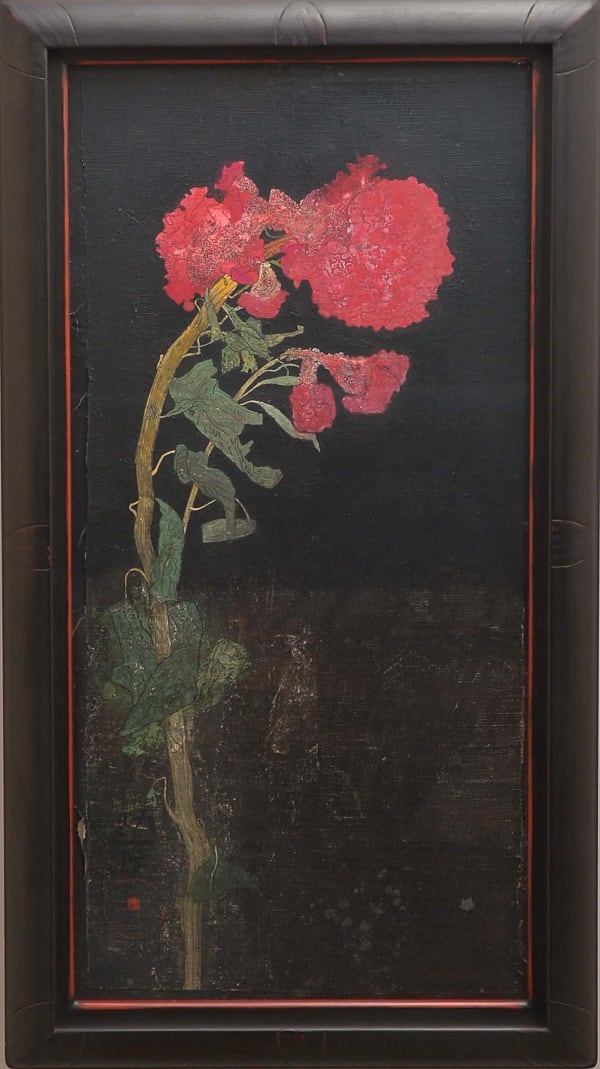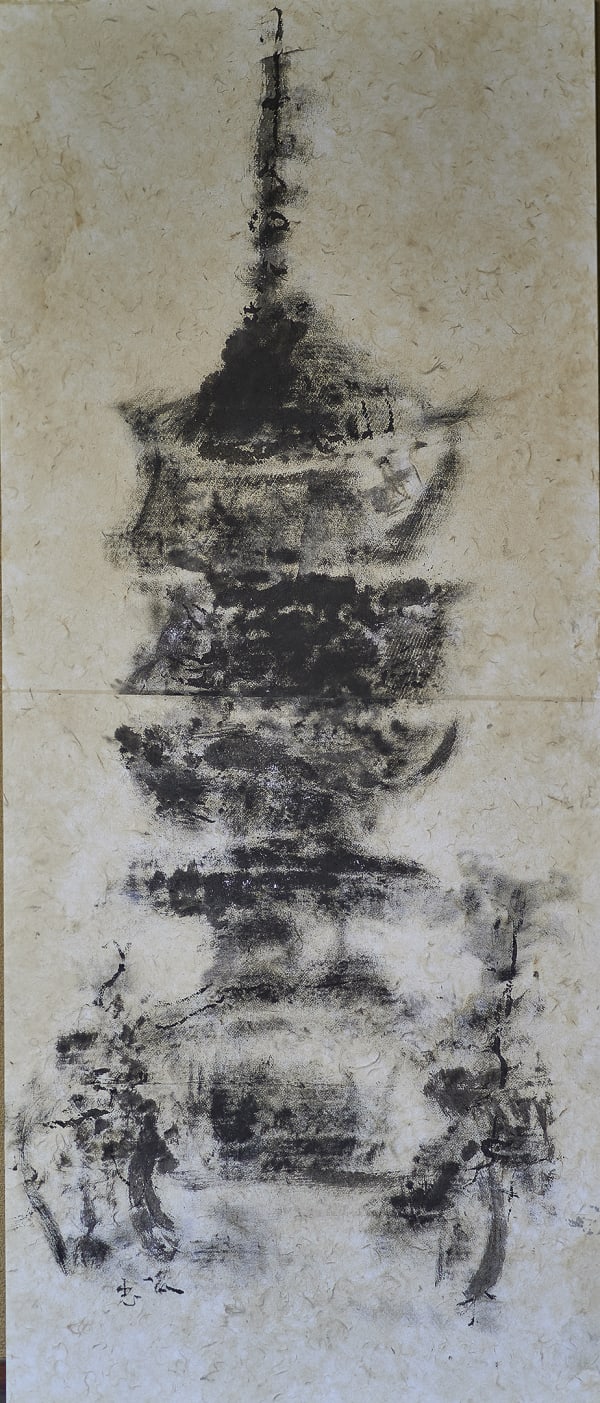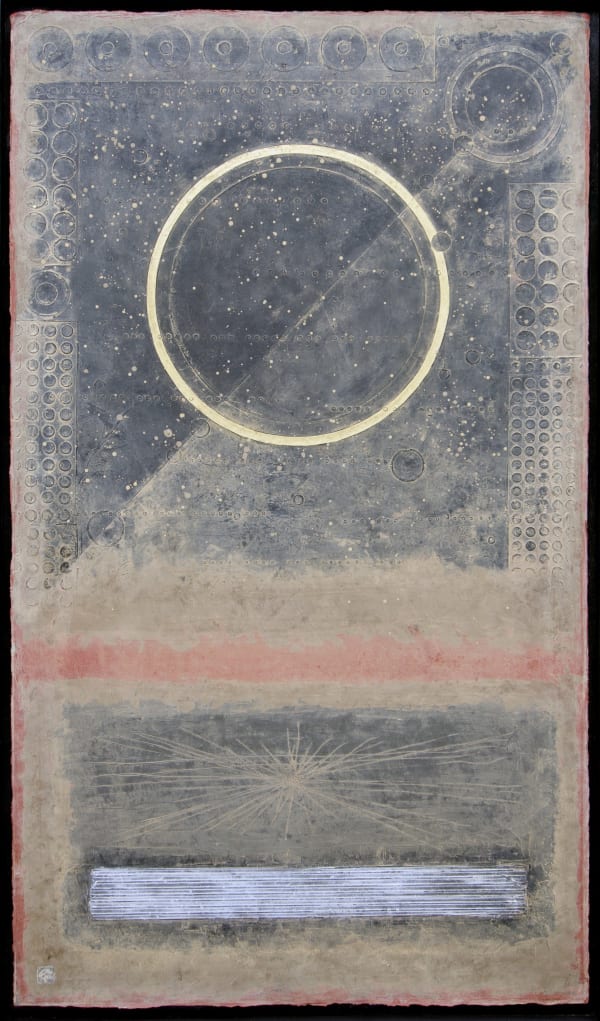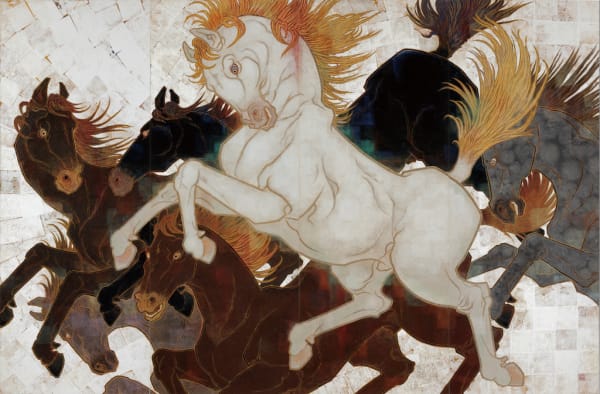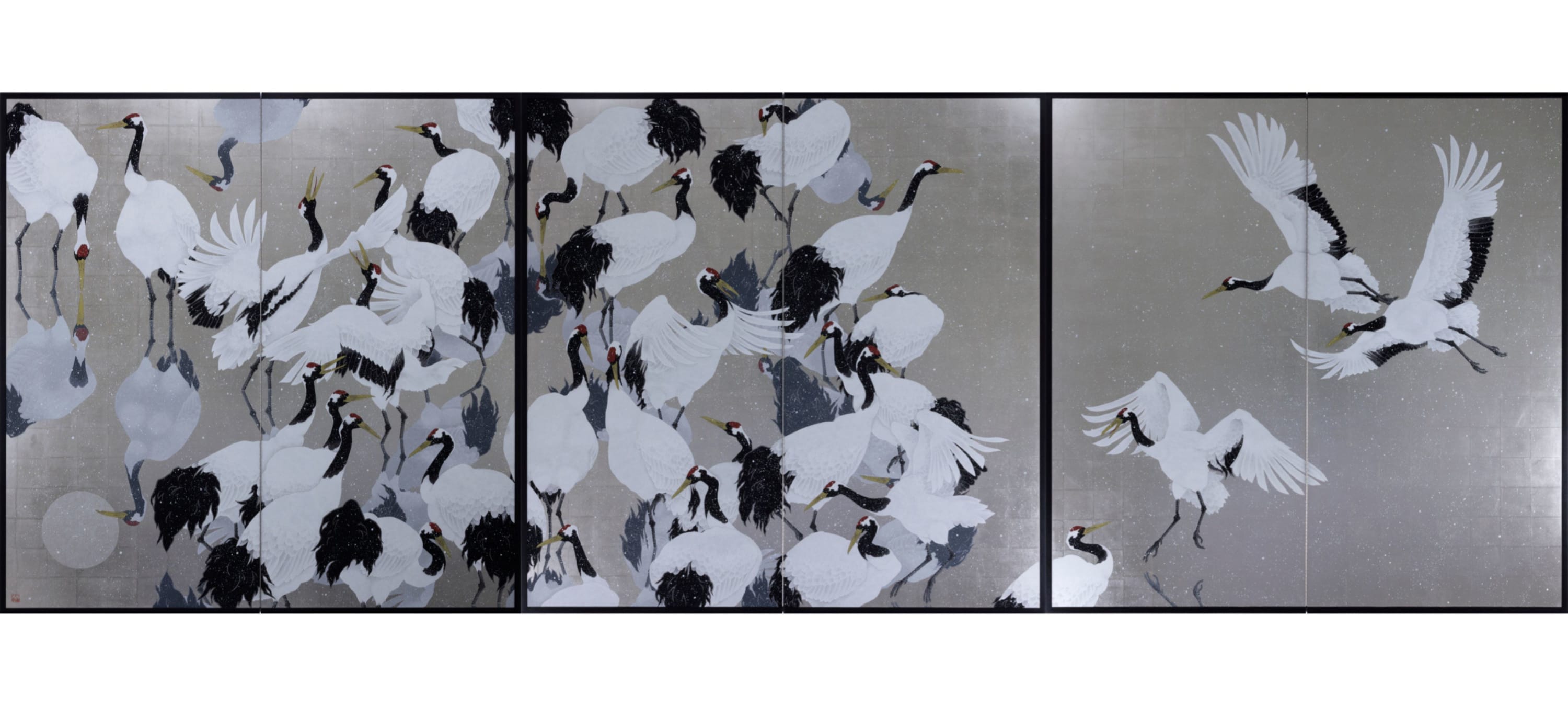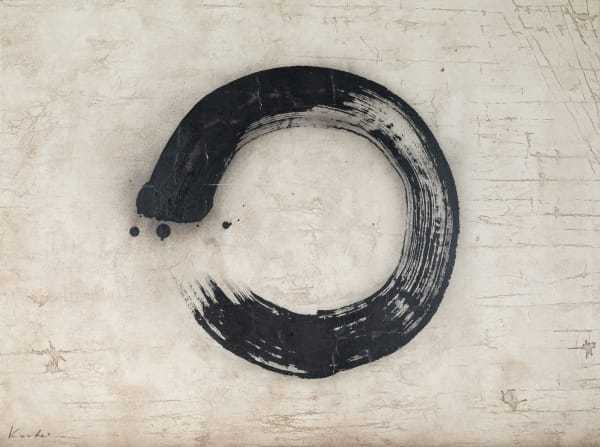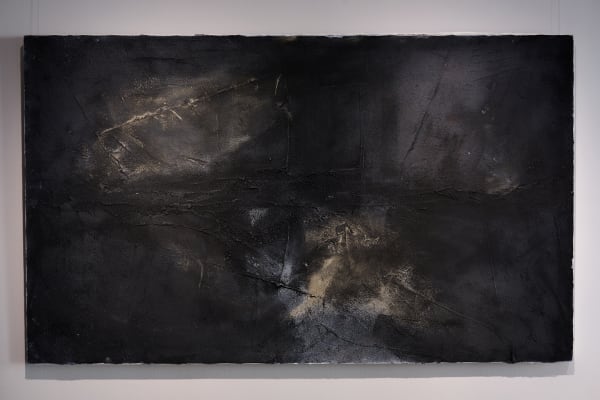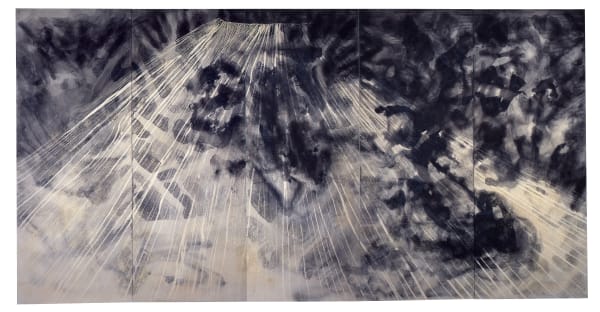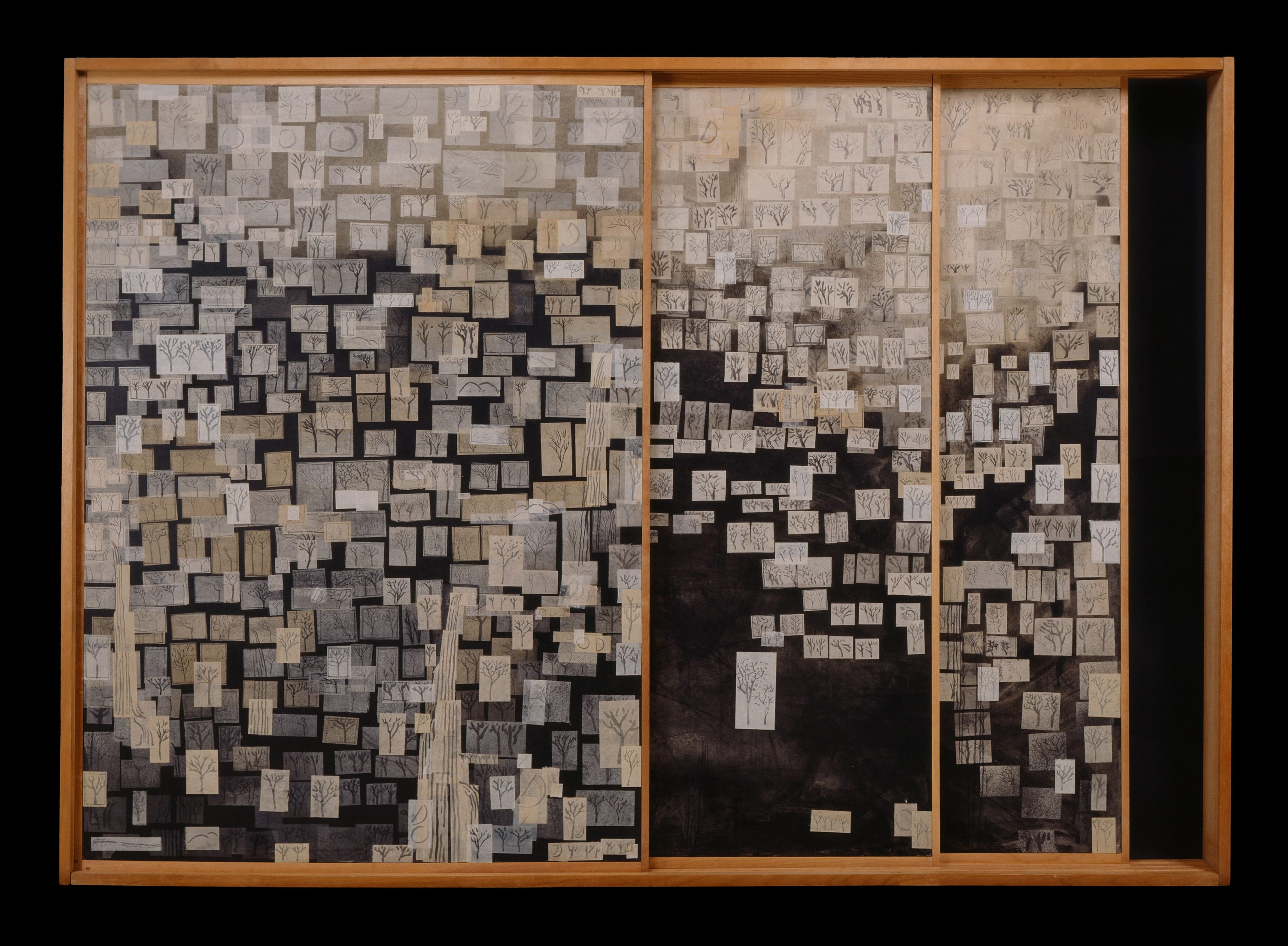-

Born in Hyogo Prefecture, Kansuke Fujii (b. 1947) now resides in Kyoto where he works as a self-taught draftsman. It wasn't until 1988 when Fujii first displayed his work in a solo exhibition in Tokyo. Throughout his career, Fujii has maintined a focus on painting still lifes of plants and nature on a dark background.
-

KAKU (b. 1950) is an internationally celebrated artist and designer based in Sagamihara, Kanagawa whose avant-garde approch to traditional Japanese materials have captivated audiences for over five decades. KAKU designs in materials including washi, lacquer, metal for exhibition installations and functional objects. His unique approaches—such as redesigning the ergonomics of a chair or the washi pieces coiled around wire into the shape of koi fish—garner much attention both overseas and Japan, and he has shown extensively around the world since 1975.
-

Tadataka Kishino (b. 1938) studied painting under Kobayashi Undo-jin and he practiced Zen meditation under Yamada Mumon Roshi at Myoshin-ji Temple. During the more than 50 years Kishino has adhered to Buddhism the call to the calligraphy practice and the ink wash painting remains keen. Kishino strictly applies a realism approach, painting from direct observation. Ink painters who have made their mark in history too had a relentless eye for detail. This intensity of seeing led to Kishino's fantastical worlds. Imagination is brought forward and coalesces around the brushstrokes, creating depth in space through lines, without relying on perspective or shading techniques. This has been the foundation of his ink style, and his career as a painter has now spanned over 50 years.
-
 Yasue Maetake (b. 1973) began her career as a glass artist, first training in Japan and the Czech Republic before settling in New York City, where she now works as a sculpture artist, transforming raw and organic materials into abstract artworks. Maetake actives her deep cultural and historical knowledge, embedding expressions of Japanese Animism, Baroque aesthetics, and industrialization into her material-centered pieces.
Yasue Maetake (b. 1973) began her career as a glass artist, first training in Japan and the Czech Republic before settling in New York City, where she now works as a sculpture artist, transforming raw and organic materials into abstract artworks. Maetake actives her deep cultural and historical knowledge, embedding expressions of Japanese Animism, Baroque aesthetics, and industrialization into her material-centered pieces. -
 The narrative environmental scenes painted by Ken Matsubara (b. 1948) combine natural pigments and materials on delicate washi paper, constructing immersive and multidimensional atmospheres from classical Buddhist imagery. Matsubara's works have exhibited by the Tokyo Metropolitan Museum of Art, and he won the museum's top award in 1977. Exhibitions of Matsubara's scenes have traveled throughout Japan, Europe, and the United States. His pieces are included in esteemed collections such as the Minneapolis Institute of Art and the Philadelphia Museum of Art.
The narrative environmental scenes painted by Ken Matsubara (b. 1948) combine natural pigments and materials on delicate washi paper, constructing immersive and multidimensional atmospheres from classical Buddhist imagery. Matsubara's works have exhibited by the Tokyo Metropolitan Museum of Art, and he won the museum's top award in 1977. Exhibitions of Matsubara's scenes have traveled throughout Japan, Europe, and the United States. His pieces are included in esteemed collections such as the Minneapolis Institute of Art and the Philadelphia Museum of Art. -
-

Ken Matsubara
"Kyokujitsu Gyōsei" Kukai's View; Sun and Venus 旭日暁星, 2017Painting
H71 x W442 in
H180 x W1125 cm
(Set of 3 panels) -
 Masaaki Miyasako (b. 1951) is a master Nihonga painter acclaimed for his revival of urazashiki; painting on both the back and surface of layered washi paper with rare and vibrant minerals, such as Azurite and Malachite. His artworks are in global collections and the permanent offices of Japan's Prime Minister. Also a professor of conservation, Miyasako led the Institute for Knowledge and Inspiration, endowed by the Agency for Cultural Affairs, in the restoration of significant artworks from UNESCO sites and museum collections around the world. Now, after a half decade, Miyasako reclaims his mantle as the greatest and most accomplished Nihonga painter of the present with his premiere solo exhibition in the United States at Ippodo Gallery.
Masaaki Miyasako (b. 1951) is a master Nihonga painter acclaimed for his revival of urazashiki; painting on both the back and surface of layered washi paper with rare and vibrant minerals, such as Azurite and Malachite. His artworks are in global collections and the permanent offices of Japan's Prime Minister. Also a professor of conservation, Miyasako led the Institute for Knowledge and Inspiration, endowed by the Agency for Cultural Affairs, in the restoration of significant artworks from UNESCO sites and museum collections around the world. Now, after a half decade, Miyasako reclaims his mantle as the greatest and most accomplished Nihonga painter of the present with his premiere solo exhibition in the United States at Ippodo Gallery. -

Masaaki Miyasako
Firework 'Aqua' - Eternal Moment - 水花火, 2023Byoubu Screens
H77 x W146 in
H195.6 x W370.8 cm -

Nihonga style painter Daisuke Nakano (b. 1974) uses an animated expression method that imbue his images with a vitality and tangible liveliness. He is precise, visionary, and patient, only producing a single artwork a year as he painstakingly perfects every line to capture perpetual movement. He depicts a sense of time standing still. Nakano explores a unique sense of space particular to Japanese fine art. Drawing on traditional Japanese painting materials, Nakano is inspired to use gold or silver leaf as a base—a method developed by Ito Jakuchu or the Rinpa School. Depicting the overwhelming power of nature and the climax of life, evanescence and sorrow take center stage: flowers in full bloom will eventually fall and return to the earth. It is the intoxicating paradox of life.
-

Daisuke Nakano
鶴の屏風 「月を渡る」Painting
H180 x W540 cm -

Kohei Nakamura (b. 1948), third son of the robust Kanazawa ceramicist family headed by Nakamura Baizan, is a master at updating classical masterpieces to match a modern point of view. Immersing his ideas amongst artistic movements from Rocco and Baroque to the ceramics of Japan’s rinpa school of art, Nakamura’s tea bowls and sculptures reference great cultural touchstones with intriguing twists; kintsugi-like Ido-style, awhite-glaze dipped kohiki, and celadon of an atypical pigmentation are prime examples of Nakamura’s mastery.
-
 Suikei Saito (b. 1945) apprenticed under Shunkei Yahagi. In 1990 she won her first prize in the 42nd Mainichi Shodo Exhibition. Since then, she has collected various awards, such as the Parliament Building Vice-President Award at Vienna New Century in 2005 and a prize at the 62nd Mainichi Shodo Exhibition Group Core at Hayama Bunkaen in 2006. Saito is in numerous public collections such as the Philadelphia Museum of Art / Philadelphia, USA, Phaya Thai Palace Collection, 70th Anniversary of King Bhumibol Adulyadej of Thailand, and The Embassy of Algeria in Tokyo, Japan.
Suikei Saito (b. 1945) apprenticed under Shunkei Yahagi. In 1990 she won her first prize in the 42nd Mainichi Shodo Exhibition. Since then, she has collected various awards, such as the Parliament Building Vice-President Award at Vienna New Century in 2005 and a prize at the 62nd Mainichi Shodo Exhibition Group Core at Hayama Bunkaen in 2006. Saito is in numerous public collections such as the Philadelphia Museum of Art / Philadelphia, USA, Phaya Thai Palace Collection, 70th Anniversary of King Bhumibol Adulyadej of Thailand, and The Embassy of Algeria in Tokyo, Japan. -

-
 Shiro Tsujimura (b. 1947) began his artistic career studying oil painting; however, he became disillusioned during this process and eventually abandoned the idea. Inspired by a classic Ido teabowl from the Folk Museum in Japan, Tsujimura embarked on the journey of ceramic arts. He is known widely known as a master of pottery as his ceramic works reflect a level of sophistication and return to nature in the various clay bodies and glazes he used. His dedication to the ceramic arts bleeds into his lifestyle. In 1967, Shiro and his wife moved to Mima, Nara, where he currently resides, and built a home, a teahouse, and seven kilns over the years.
Shiro Tsujimura (b. 1947) began his artistic career studying oil painting; however, he became disillusioned during this process and eventually abandoned the idea. Inspired by a classic Ido teabowl from the Folk Museum in Japan, Tsujimura embarked on the journey of ceramic arts. He is known widely known as a master of pottery as his ceramic works reflect a level of sophistication and return to nature in the various clay bodies and glazes he used. His dedication to the ceramic arts bleeds into his lifestyle. In 1967, Shiro and his wife moved to Mima, Nara, where he currently resides, and built a home, a teahouse, and seven kilns over the years. -
 Ikuro Yagi (b. 1955) maintains his innovative nihonga painting practice from his home in Shizuoka Prefecture where his roots have long been set. Yagi’s home city is framed by mountains, forests, rivers and the sea, and he sees no barrier between man-made spaces and the surrounding terrain which he depicts prominently. His education brought him to Paris following study under nihonga master Matazo Kayama at Tama Art University and western-style painter Koji Kinutani. The French influence invigorated his approach to nihonga styles, the medium through which he began to depict all sorts of material culture. His vivid paintings of sea creatures, flowers in bloom, and all other sorts of wilderness draw on decorative traditions that defined nihonga painting in the era of ornate interiors during the Edo period (1603-1868). Yagi began working with the Agency for Cultural Affairs in 1985, and his works have exhibited widely in Japan and received many accolades.
Ikuro Yagi (b. 1955) maintains his innovative nihonga painting practice from his home in Shizuoka Prefecture where his roots have long been set. Yagi’s home city is framed by mountains, forests, rivers and the sea, and he sees no barrier between man-made spaces and the surrounding terrain which he depicts prominently. His education brought him to Paris following study under nihonga master Matazo Kayama at Tama Art University and western-style painter Koji Kinutani. The French influence invigorated his approach to nihonga styles, the medium through which he began to depict all sorts of material culture. His vivid paintings of sea creatures, flowers in bloom, and all other sorts of wilderness draw on decorative traditions that defined nihonga painting in the era of ornate interiors during the Edo period (1603-1868). Yagi began working with the Agency for Cultural Affairs in 1985, and his works have exhibited widely in Japan and received many accolades. -
-

Ikuro Yagi
Beyond the Forest 森のかなた, 1984Washi paper collage, Sumi ink, powdered pigments
H85 1/2 x W120 x D6 3/4 in./H217.2 x W304.8 x D17.2 cm overall
3 panels, H80 3/4 x W57 1/2 in./H205 x W146 cm each
11.5kg/25lbs each with frame

